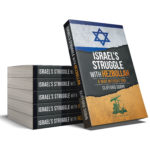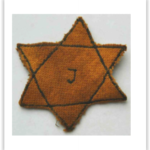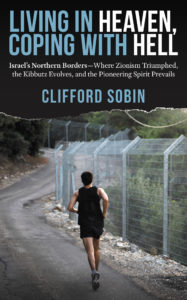Today, Israel has reached a decision point: will it accept the status quo with Hezbollah or will Israel force a change if diplomatic efforts fail? The eighty thousand evacuated inhabitants of the now emptied forty-two communities and one city located close to the Lebanese border, currently living in temporary shelters, will only return to their homes when it is safe to do so. Now it is not. Hezbollah’s daily firing of missiles and drones targeting civilians and military targets in the north (almost 5,000 as of April 1, 2024), along with its capability to initiate an even more deadly October 7, make it unsafe to go back. As a result, that now barren region is devoid of civilian activity and most economic pursuits are at a standstill. Farther back, Israeli citizens are at risk too. And so is Israel’s future imperiled if Hezbollah succeeds in challenging Israel’s sovereignty and use of lands that have been part of the nation since its founding in 1948.
The direct culprit is Hezbollah, behind which stands Iran.
Simply put, Hezbollah is Iran’s creation planted deeply in Lebanon—but with worldwide tentacles. It is a hybrid terrorist organization, a ruling governmental power in Lebanon, and it presents a grave threat to Israel. Led by Hassan Nasrallah, Hezbollah is a Shiite organization dedicated to Israel’s destruction that is funded primarily by Iran and Hezbollah’s international criminal enterprises—including in the United States. And it is powerful, resourceful, and resilient.
Therefore, since Hezbollah is likely to remain a threat to Israel for a long time to come, it is important to understand what Hezbollah is, how it grew, its track record, and what it is capable of. To do that, this article is divided into four parts. This, part one, covers the early days of Hezbollah but first takes a necessary, shallow dive into Lebanon’s history which is one of religious strife, cruelty, and dysfunction. Part two tracks Hezbollah’s growth over the following twenty years. Part three begins with the Second Lebanon War in 2006 and ends with Hezbollah’s battle and political experience through 2019. Part four describes Hezbollah’s present military assets and reviews pertinent events of the last four years, up to the summer of 2023, that were warning signs of Hezbollah’s newfound aggressiveness.
Lebanon Before Hezbollah
For centuries, the population of Lebanon has mainly consisted of four major religious groups: Christian, Shiite Muslims, Sunni Muslims, and Druze. In 1943, when Lebanon first became an independent nation, Christianity (mostly Maronites) was the religion that somewhere between a slight majority or largest minority of people in Lebanon identified with. They were followed by Shiites, Sunnis, and bringing up the rear with only a few percentage points of the population, the Druze. Therefore, as part of the deal the Maronites negotiated with France to gain independence, an agreement known as the National Pact was reached. The most important governmental aspects of that unwritten deal were:
- The President and the Commander of Lebanon’s armed forces must be a Maronite Christian.
- The Prime Minister must be a Sunni Muslim.
- The Speaker of the Parliament must be a Shiite Muslim.
- The ratio of Christians to all other religions in parliament must always be 6:5.
In effect, this meant that Christians would control Lebanon’s government.
For the next thirty years all went relatively well, despite some widening fissures that included:
- A change in demography within Lebanon due to differing birth rates and emigration. Those identifying as Sunni or Shiite at some point cumulatively took over majority status from the Christians.
- King Hussein evicted the Palestinian Liberation Organization (PLO) from Jordan in the early 1970’s. As a result, many members of that Sunni terrorist organization moved to Lebanon and took control in Southern Lebanon.
- Sunnis somewhat prospered while Shiite economic conditions stagnated or worsened. In effect Shiites became second class citizens, never loved by the Christians, and hated by the Sunnis—an enmity that began decades after the death of the Prophet Muhammad in 632 CE due to differences over how successor leaders of the Muslims should be chosen.
Then, in April 1975, an extremely destructive and bloody Civil War broke out in Lebanon. Primarily, it was fought by the Christians against the PLO and the Sunnis, with some Druze involvement. The Shiites mostly sat it out. Not so the Syrians, whose main goal was to take control of Lebanon, but in furtherance of it flip flopped more than once as to which side it supported.
By 1979, most of the bloodshed was over, although the conflict still simmered. However, a new player was soon to exert influence in Lebanon—Iran—the most powerful Shiite state in the world. In April 1979, Ayatollah Khomeini had returned from exile to take control of Iran. He declared that Iran would now be an Islamic republic guided by Shiite religious values. And, for good measure, he spewed a virulent hatred for Israel. In 1980, Syria and Iran issued a joint communique binding both nations to friendship and bilateral support for their mutual hatred of Israel, Egypt, and the United States. Simultaneously, Ayatollah Khomeini plotted to impose his brand of Shiite ideology and revolution worldwide. Lebanon—with its mass of Shiites already connected in many ways to Iran and resentful of their inferior political, social, and economic status—was low hanging fruit. Therefore, it was not long before Iranian agents arrived to radicalize the Shiites in Lebanon. And for the next decade a struggle ensued among Shiites between those energized by Iran’s agents and a more secular Shiite organization known as AMAL.
Hezbollah—An Iranian Proxy—Is Born in 1982
No discussion of the origins of Hezbollah is complete unless it illuminates the unintentional part played by the PLO. After the PLO’s eviction from Jordan and its arrival in force in southern Lebanon in the early 1970’s, the level of terrorist activity emanating from Lebanon at the PLO’s behest increased substantially. The years between 1974 and 1982 were particularly bloody. PLO terrorists crossed the border to indiscriminately kill Israeli citizens, including children, and the PLO’s minions indiscriminately fired rockets at Israeli towns along the northern border. This is when the massacres at Ma’alot, Kiryat Shmona, Nahariyah, and the bus attack that killed thirty-eight Israelis south of Haifa occurred. So too at Misgav Am where PLO terrorists took toddlers captive. Therefore, it was no surprise when in June 1982, Israel’s government unleashed Israel’s Defense Forces (IDF) on the PLO to drive the terrorist organization back from the border. By the end of August, the IDF had succeeded in pushing the PLO out of Lebanon. Nevertheless, because the operation had other goals and because of issues over whether those goals were properly disclosed to decision makers, as well as other related matters, there remains much controversy concerning the 1982 war, all of which is beyond the scope of this article.
However, what is important for this discussion, is that Iran saw an opportunity it was determined pursue.
Two days after the IDF crossed the border into Lebanon, an Iranian delegation went to Damascus to discuss providing Iranian military support for Syria and the entry of more Iranians into Lebanon. Soon 5,000 Islamic Revolutionary Guard Corps members arrived in Syria. Iran had hoped to embroil them in the fight with Israel inside Lebanon. But by then the fighting had ebbed. Therefore, Syrian president, Hafez al-Assad (father of now president, Bashar al-Assad), feared that their entry would restart the fighting which had involved the Syrian army. Nevertheless, Assad allowed 1,500 of them to enter Lebanon from Syrian land. Many went to Baalbek, the largest town in the Bekaa Valley, which was predominately Shiite. Soon, they were busy traveling to throughout the region—pushing the teachings of Khomeini and building a foundation for hatred of Israel.
The converted operated at first under the name, Islamic Amal, to separate themselves from the more secular members of AMAL. As such, there is scholarly debate as to whether Hezbollah began in 1982, 1984, or 1985 when the organization officially announced itself to the world. But make no mistake, Hezbollah’s origin, if not founding, was in 1982. Iran provided the nutrients and Syria, with its border with Lebanon, the feeding tube.
If you think of Iran’s and Syria’s goals as two circles of a Venn diagram, Hezbollah occupied the middle where the two circles intersected. Syria wanted to control events in Lebanon for its own economic and hegemonial dreams and to create leverage to use against Israel in hopes of recovering the Golan heights. Iran wanted to push its ideological Shiite revolution throughout the Middle East. Both nations hated Israel. As such, Hezbollah was a perfect vehicle for furthering their nefarious causes.
By later summer of 1982, organized Shiite resistance began to confront the IDF and allied Christian forces. Meanwhile, a steady supply of weapons sent by Iran moved through Syria into the Bekaa valley into Hezbollah’s hands. At first, both the IDF and Amal failed to appreciate the danger Hezbollah presented. But it was not long before the IDF felt Hezbollah’s growing power and Amal found itself being swallowed whole.
Later in the year, Hezbollah (sometimes using the name of Islamic Jihad that was an arm of Hezbollah’s) initiated a bombing and kidnap campaign. Within a year, bombs delivered by suicide drivers struck IDF headquarters buildings, the American Embassy, and an American marine base. Hundreds of Americans and dozens of Israelis died in the blasts. In addition, Hezbollah launched an insidious kidnapping campaign that lasted years and took captive more than 100 Americans and Western Europeans. It also captured the American CIA station chief in Lebanon and years later the American chief of the UN Truce Supervision Organization—savagely torturing and then killing both. 1985 also saw Hezbollah’s hijack of TWA Flight 847, during which a Hezbollah hijacker killed an American soldier who was a passenger on the plane and tossed his body to the tarmac.
Amid all this mayhem, Hezbollah came out from the shadows. On February 16, 1985, Hezbollah revealed itself to the world at a press conference from a mosque in Lebanon and published a manifesto that its spokesperson read aloud. The document contained four major themes:
- Hezbollah’s clear desire to obliterate Israel. It said in part, “Israel’s final departure from Lebanon is a prelude to it final obliteration from existence and the liberation of venerable Jerusalem from the talons of occupation.”
- A demand that “Imperial Powers” must leave Lebanon—meaning the United States and France.
- A call for Lebanon to decide its own future but a prediction that it would choose Islam. Left unsaid was how much of that prediction would be based on planned coercion.
- A confirmation of Hezbollah’s strong allegiance to Iran and its Supreme Leader.
This was Hezbollah’s coming-out-party. Hassan Nasrallah, now Hezbollah’s leader for the last three decades, later said, “After 1985. . .was when the popular resistance ended and organized armed resistance began.” Now, Hezbollah began its meteoric growth.
A new era had begun.





